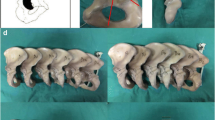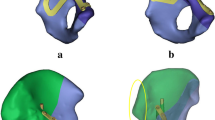Summary
Ten fresh frozen specimens of a hemipelvis, including the hip joint, capsule and proximal femur, from elderly cadavers were used to evaluate three methods of internal fixation of isolated posterior column osteotomies. Intact and reconstructed specimens were tested at 30° and 60° of hip flexion in a specially designed joint simulator: The three methods of fixation used were a single 3.5 mm reconstruction plate, two such plates, and a 4.5mm lag screw with a single plate. Motion at the fracture site in three orthogonal directions, and the overall stiffness of the construct, were recorded simultaneously. No significant differences were noted in stiffness for the three procedures and all retained 80% of the intact stiffness. At 60° of flexion, smaller interfragmentary compliances were allowed by fixation with a lag screw and a neutralisation plate (p<0.05). At 30°, the position of the load plane relative to the fracture plane allowed less interfragmentary motion, so that no significant differences were found between the 3 methods.
Résumé
Dix hémi-bassins comportant la capsule articulaire de la hanche et le tiers supérieur du fémur ont été prélevés sur des cadavres frais congelés, afin d'évaluer trois méthodes actuellement utilisées pour l'ostéosynthèse des fractures isolées de la colonne postérieure du cotyle. Cette fracture a été simulée par une ostéotomie. Les spécimens intacts et reconstruits ont été montés dans un appareil à tester les matériaux, simulant un mouvement articulaire. Les tests ont été effectués à 30° et 60° de flexion de hanche. Trois types d'ostéosynthèse ont été étudiés séquentiellement sur chaque hémi-bassin: une plaque à reconstruction de 3,5 mm, deux de ces plaques placées sur la colonne postérieure, soit enfin une vis de traction de 4,5 mm associée à une plaque de neutralisation. Les déplacements interfragmentaires dans trois directions perpendiculaires ainsi que la rigidité globale du système ont été enregistrés simultanément pendant les tests. Concernant la rigidité, aucune différence statistiquement significantive n'a été notée entre les types de fixation pour les deux amplitudes articulaires. Les hémi-bassins reconstruits ont tous atteint 80% de la rigidité des spécimens intacts. En terme de déplacement interfragmentaire, à 60° de flexion de hanche, les fractures fixées par la vis de traction et une plaque de neutralisation se sont révelées plus stables que les autres (p<0,05). A 30° de flexion, les déplacements interfragmentaires sont restreints et les différences ne sont pas statistiquement significatives.
Similar content being viewed by others
References
Bosse MJ (1991) Posterior acetabular wall fractures: a technique for screw placement. J Orthop Trauma 5: 167–172
Ebraheim NA, Savolaine ER, Hoeflinger MJ, Jackson WT (1989) Radiological diagnosis of screw penetration of the hip joint in acetabular fracture reconstruction. J Orthop Trauma 3: 196–201
Goulet JA, Bray TJ (1989) Complex acetabular fractures. Clin Orthop 240: 9–20
Heeg M, Klasen HJ, Visser JD (1990) Operative treatment for acetabular fractures. J Bone Joint Surg [Br] 72: 383–386
Letournel E (1980) Acetabulum fractures: Classification and management. Clin Orthop 151: 81–106
Mason DJ, Goulet JA, Rouleau JP, Golstein SA (1991) Comminuted posterior wall fractures of the acetabulum: a study of fixation stability. Orthop Research Society, 37th Annual Meeting, Anaheim, California
Matta JM, Letournel E, Browner BD (1986) Surgical management of acetabular fractures. Instructional course lectures, AAOS
Matta JM, Merritt PO (1988) Displaced acetabular fractures. Clin Orthop 230: 83–97
Mayo K (1987) Fractures of the acetabulum. Orthop Clin North Am 18: 43–57
Mears DC, Gordon RG (1990) Internal fixation of acetabular fractures. Techniques Orthop 4: 36–51
Müller ME, Allgöwer M, Schneider R, Willenegger H (1991) Manual of internal fixation, 3rd edn. Springer, New York Berlin Heidelberg
Routt MLC, Swiontkowski MF (1990) Operative treatment of complex acetabular fractures. Combined anterior and posterior exposures during the same procedure. J Bone Joint Surg [Am] 72: 897–904
Sawaguchi T, Brown TD, Rubash HE, Mears DC (1984) Stability of acetabular fractures after internal fixation: a cadaveric study. Acta Orthop Scandinavica 55: 601–605
Tile M (1984) Fractures of the pelvis and acetabulum. Williams and Wilkins, Baltimore
Author information
Authors and Affiliations
Rights and permissions
About this article
Cite this article
Schopfer, A., DiAngelo, D., Hearn, T. et al. Biomechanical comparison of methods of fixation of isolated osteotomies of the posterior acetabular column. International Orthopaedics 18, 96–101 (1994). https://doi.org/10.1007/BF02484418
Accepted:
Issue Date:
DOI: https://doi.org/10.1007/BF02484418




